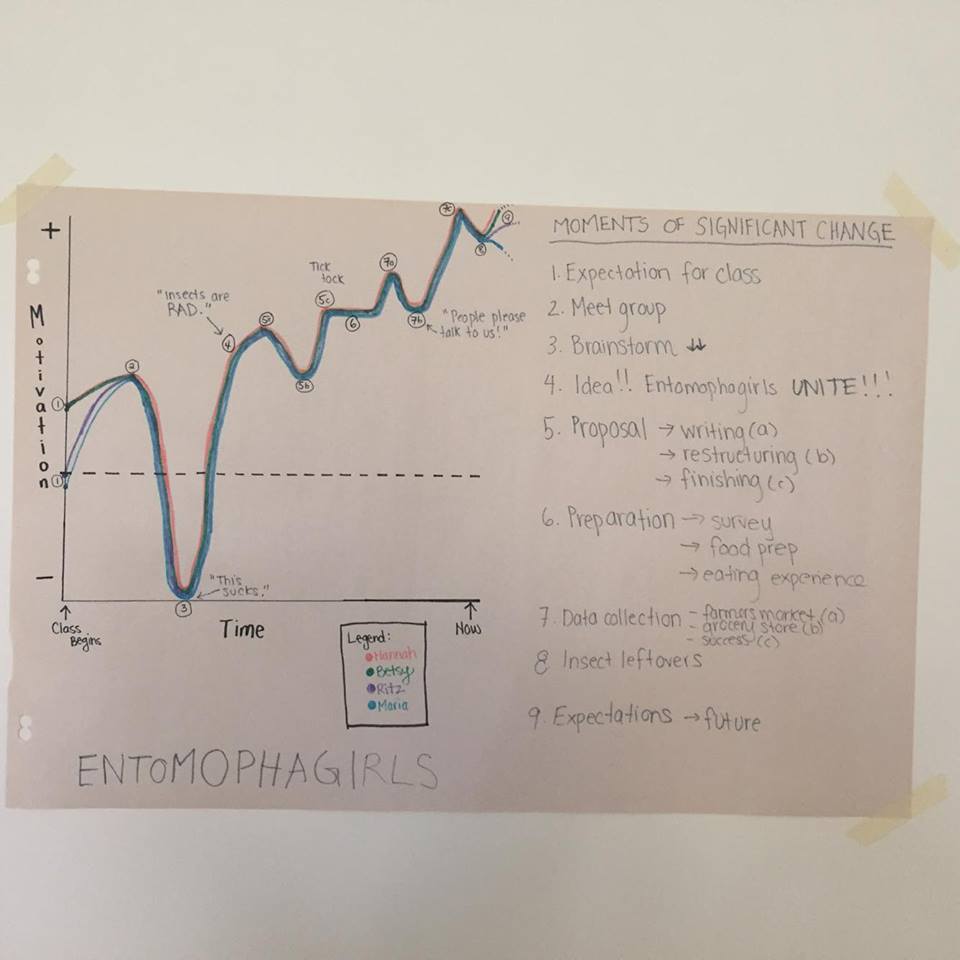Hello again! We know you can’t wait to see what we’ve been up to, but before we begin, it’s time for our hilarious joke!
Q: Why was the grocery store out of butter? (keep reading to find the answer)
With only five weeks left until our final project presentation, the Entomophagirls have been very busy. A few very notable accomplishments have been made, and we have begun some crucial steps for completing our project! We have reflected on some moments that have made us laugh, cry (not really though), and scream (actually!). Moving forward, we have discussed our strategies for completing this project successfully, while maintaining our sanity (if we ever had any to begin with). Let us tell you all about it.
Achievements
This week was our most eventful yet! Here are the highlights:
- Betsy invited 1500 new friends to her place, the rest of the Entomophagirls joined the party, shenanigans ensued, and the only remnants were the Entomophagirls (phew!) and some scrumptious delicacies.
- Our group then ventured out into the Riley Park-Little Mountain (RP-LM) community, set up a pseudo-bartering system on prime real estate, and exchanged treats for insightful opinions from community members
- Paperwork, paperwork, paperwork
… Let us explain.
As you may know from our proposal, we intended to cook up cricket treats to entice Riley Park-Little Mountain (RP-LM) community members to participate in our survey. Great news! The baking and data collection parts of our project were a tremendous success.
Betsy picked up the crickets—it was a noisy yet peaceful ride home—and then placed them in her freezer where they drifted into an eternal slumber. Freezing them for more than 24 hours may be the most humane way to kill the little guys.

ZzZzZz
Baking Day!
The frozen crickets were boiled for 2 mins, sorted (to separate out the ones that had fallen apart during freezing and boiling), and then roasted for 60+ mins. We unanimously agreed that cooking crickets didn’t produce the most pleasant smell. This step should definitely be done well in advance of any buggy dinner parties. (But not too far in advance! They have a better texture when fresh.)

“They’re Definitely sleeping right?”
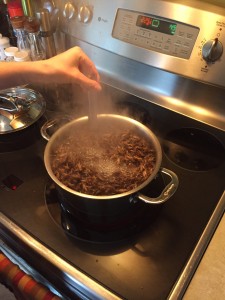
This does NOT smell okay

Body. Head. Legs… Check.
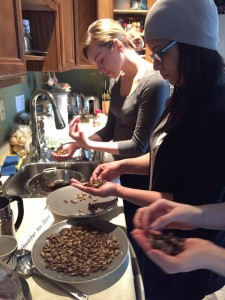
…

Crispyyyy
We wouldn’t live up to our group name if we didn’t try them fresh out of the oven, so….
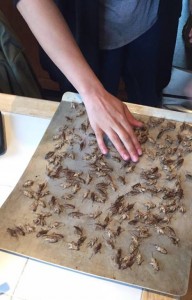
First impressions
Ritz: “Oh, it’s not that bad actually, they taste like tortilla chips”
Hannah: “They remind me of veggie crisps.”
Maria: “Kind of crispy, they don’t taste at all like they smell!”
Betsy: “I’m relieved… you totally can’t tell it’s a cricket in your mouth!”
Entomophagirls’ final verdict:

Once the crickets are boiled and roasted, there are so many ways you can use them—you’re really only limited by your imagination!
We chose: spiced crickets, chocolate covered crickets and cricket chocolate chip cookies.
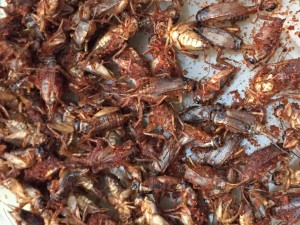

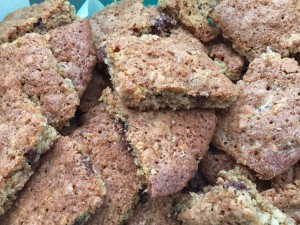
But take a look at some of these other genius and delicious uses of crickets. Recipes available from Eat-A-Bug Cookbook and cricketflours.com.
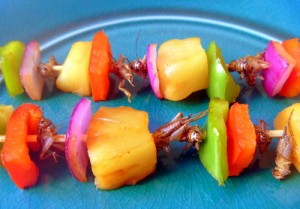
Shish Ke-Bug

Cricket Flour Brownies

Frozen Cranberry Mango Smoothie
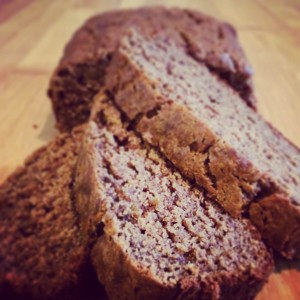
Chocolate Espresso Banana Bread with Cricket Flour
Don’t pretend you’re not tempted!
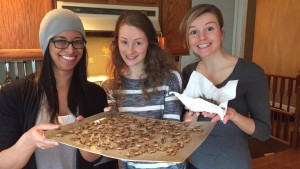
How did we make the cricket chocolate chip cookies, you ask? Well, we “liberated” the roasted crickets of most of their legs and antennae by crunching them up with our hands—their legs were sharp so we used a paper towel—then we blended them up Magic Bullet-style and used a sieve to get a finer powder. Et voilà!
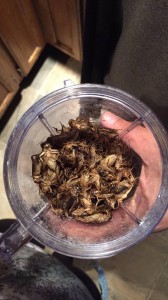
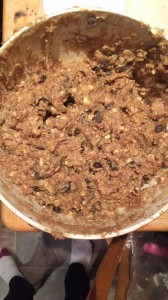

We also made identical chocolate chip cookies sans crickets for RP-LM residents that preferred to maintain a bug-free diet.
Survey Day!
We set up shop at the Nat Bailey Farmers market on a brisk Saturday morning…
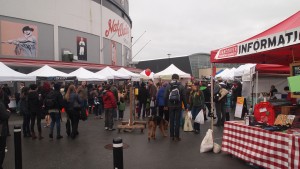

A few minutes later, this happened…
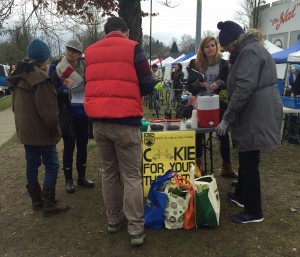
People came in droves with their shopping bags, bicycles, and kids in tow wanting to try our treats and take part in the survey! We got more than our necessary 20 participants within a couple of hours and received plenty of “good for you” and “great idea” comments from the community.
Yup, we were pumped!

to the grocery store!
Choices Market on Cambie was our store of choice (couldn’t resist) because it was one of the bigger grocers in RP-LM (= more foot traffic) and would likely get more local shoppers than the other options we considered.
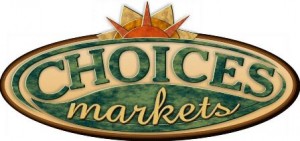

We also found out that Choices sells roasted crickets from EntomoFarms.

Kismet? We think so.
Appetites for our buggy treats weren’t as ravenous here as at the farmers market, but we still managed to get all 20 participants before calling it a day.
Post-Data Collection!
The next few days consisted of transcribing the recorded interviews, inputting participant responses onto an excel sheet and getting everything organized in preparation for the looming d a t a a n a l y s i s section of our project.
Here’s a sneak peek:

“I just think it’s a really cool alternative source of protein and it’s sustainable as far as I understand. It kind of freaks me out, but I’m trying to get over that!” – Anonymous
Which brings us to our…
Upcoming Weekly Objectives!

Image retrieved from: http://giphy.com/gifs/uTfOt7RT9bMWs
Moving forward…
Over the next couple of weeks, we hope to complete the analysis of our community survey data and begin preparing for our final presentation and writing our final report. Though, for now, the primary focus will be on data analysis. This will include:
- Quantitative analysis of the yes-or-no questions,
- Finding key themes in the open-ended questions,
- Analysing frequencies of key themes and patterns of occurrence of key themes, and
- Putting together graphs and tables to communicate all of these analyses
We will start by analysing the open-ended answers to find key themes. We will each do this separately, coming up with three primary key themes, and then meet up to discuss the best ideas. Our goal is to find three distinct and clear themes that summarize the most common and/or most important answers that we received during the survey.
For the remainder of the data analysis, we will split up the task list to tackle multiple aspects at once. We will bring our results together, discuss and critique everything, and then return to individual work to modify and smooth things over as necessary. We really are relying on team work to make this part of the project go smoothly, as this seems to be an overwhelming task for most of us!
One of the reasons this part of the project can feel so overwhelming is because of the diversity of data types we have in our survey data. We have both quantitative and qualitative data, and we’re also using both deductive and inductive analysis techniques. Deductive techniques (or those that start with some sort of hypothesis that we wish to test) will be used to analyse the quantitative yes-or-no questions about whether or not community members are aware of and open to participating in entomophagy and insecticulture. While we expect they would be both aware and open given the current level of involvement in urban agriculture in the RP-LM community, we don’t necessarily know what their reasons for being open (or not) may be. Therefore, we will be using inductive techniques to create some sort of hypothesis about these reasons for the RP-LM community by analysing the qualitative open-ended questions about why community members may or may not be willing to participate in these insect-related practices.
This diversity in data analysis techniques makes it a little more challenging for our novice data analysis minds to fully grasp. However, we have actually started to analyze the quantitative data despite deciding to start with the qualitative data (productive procrastination at its finest), and have nine clear graphs to help us see the deductive portion of this analysis much more clearly (click here for a sneak peek of one of our graphs showing the level of awareness of entomophagy among our survey participants). This has eased our minds a little bit, but we are still left with the more challenging inductive analysis of the key themes.
However, as we will explain below, our more recent achievements have left us at a very high level of motivation. So we’re definitely on the up and up and hope to continue this way even throughout this next stage!
Moments of Significant Change
Our class tutorial this week allowed our group to reflect upon the struggles and successes we have encountered thus far in our project.
As discussed in this post, our food preparation and data collection went smoothly, and we are feeling motivated (although a bit nervous) to start analyzing our data and writing our paper. We recruited more participants than originally expected and we have gathered data that will answer our research questions. However, the peak point we are at today didn’t come without some frustrating moments… we have had ups and downs, struggles and successes, laughs, and “ugh this sucks” moments (as shown in the graph below).
Not surprisingly, when our group collaborated to investigate individual moments of significant change, we all had similar events in mind. The graph above illustrates our positive/negative feelings and general motivation as a result of these moments.
Our first significant moment began with our individual expectations for LFS 350. Hannah and Betsy were optimistic about meeting the group members and exploring the projects offered for the term. Ritz felt a little more reserved about the prospect of this course, and Maria entered the class skeptical about the focus on group work. After meeting the group, our optimism and motivation towards the class increased as we felt comfortable and pleased with the initiative displayed by fellow group members.
One of the most influential moments in our journey thus far was our brainstorming period. As displayed by the ultra-dip to the negative portion of our graph (point 3) , we felt extremely discouraged. The other groups in our tutorial section appeared to have ideas for their projects, but we fell flat. We had nothing to say, few ideas, and our conversation kept running in circles. After what seemed like a long time, we settled upon our beautiful buggy project with some input from Adrienne and Will. A major turning point was not only settling on a project, but taking the time to have a discussion during which we each outlined the reasons for our individual investment in this particular topic. Thanks to Maria’s creativity, our group name was born and our motivation quickly rose (point 4).
Writing our proposal allowed us to clarify concepts and our timeline, and we felt good as our ideas were beginning to come together in a concrete form (point 5a). However, things got a little messy when we had to restructure our proposal after receiving feedback during the proposal-review tutorial session, slightly wavering our motivation. With equal efforts from all team members, we regained confidence upon completion of our proposal and after receiving positive feedback from our instructor (points 5b and 5c).
As displayed on the graph, our motivation towards our project during preparation for data collection was fairly consistent. We worked to finalize the survey, gather the ingredients and prepare the food samples with minimal stress. We didn’t have any setbacks, and everything went fairly smoothly (point 6).
The day of data collection had it’s ups and downs (as you can see in the graph towards points 7-8). Conducting the survey at the farmers market was successful, as we gathered more participants than originally expected, and were extremely well-received by local community members. At this point in time we felt very motivated and connected to our project. However, this motivation took a hit at the grocery store, where we had a harder time recruiting participants, as many locals seemed to be in a rush and just didn’t have time to answer our questions. After a few hours, we managed to collect enough surveys, and we felt satisfied and accomplished after all of our hard work.
We are still feeling this “high” from our data collection weekend, and we are looking forward to analyzing the valuable data and drawing out the major themes from the open-ended questions of the survey. We can all agree it feels good to have tangible data and to be at the stage where we can begin to create our informative paper, even though the prospect of looking at the data and narrowing it down to only three major themes seems seems like a large (ant)hill to climb. However, analyzing Miewald and Ostry’s (2014) paper in class provided us with an example for analysis, which has helped ease our worries. They have provided an example for the pattern of which to follow, and how to use quotes from survey participants within research papers. We are all nervous but excited about consolidating the data and analyzing our results (point 9).

The Graceful Dismount
We are now at the final stages of our project, and everything is beginning to come together. The last few weeks of the semester will require hard work, superb collaboration, and effective communication.
One of the most crucial parts of our project is data analysis. This will be done through achievement of our objectives for the week. The EntomophaGirls will then begin the process of forming our final report and final project presentation.
The report will require us to collaborate and identify the key points we wish to include before commencing individually. We will strive to answer all of our inquiry questions as the basis of our report. Due to the limited word count, our report must be concise and coherent. It is therefore crucial that we must omit some points that, though we find interesting, may not be especially valuable for our report. We will create tasks for completion and determine which member will complete each task. We will each write a few sections of the report individually and then collaborate again during the editing process to ensure everything is consistent and comprehensible.
As a group, we have agreed that communication is crucial to successful completion of this project. That being said, we will advise each other when needed and inform each other when we may be struggling with a task or falling behind on our own dates of completion. Meeting times will be arranged well enough in advance with a time that suits everyone’s needs. Most of the work can be done through online communication, though preparing for the presentation will require face-to-face communication outside of class time. We will need to bake our class samples a day prior and practice the presentation.
As a group, aside from working together intellectually, we will endeavor to promote a positive well-being in each other. This can be done through stress management, communicating areas of concern, and avoiding burdening one another with an unfair work load. It is understood that each member has other responsibilities outside of the completion of this project. This makes it even more crucial to collaborate effectively and communicate within the group. The final stages of this project should be enlightening and satisfying for the entire group, rather than a burden on any individual.
Now, here’s the answer you’ve been waiting for!…
Q: Why was the grocery store out of butter?
A: Because Butter flies.

Image Retrieved from: http://ih1.redbubble.net/image.197386551.6626/flat,1000×1000,075,f.jpg
Thanks for reading!
Reference
Miewald, C., & Ostry, A. (2014). A Warm Meal and a Bed: Intersections of Housing and Food Security in Vancouver’s Downtown Eastside. Housing Studies, 29(6), 709–729.

